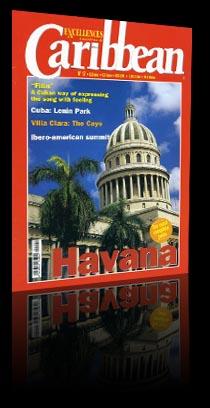Villa Clara. A paradisiac destination history, nature and beaches intermingle here.
An intense development tourism program is being implemented in Villa Clara province, situated on north central region of Cuba, whose aim is the commercial operation of a number of cays for leisure purposes. The cays are located on the north facing its coastline.
Magnificent beaches are found along these cays, especially those located on the northeast: Fragoso, Cobos, Francés, Las Brujas, Ensenachos and Santa María. The main attractions of this area is the captivating virgin nature, the white sands and crystal-clear waters. The lively and paradisiacal presence of this natural site can now be admired by us thanks to today's man and the state-of-the-art technology. We can technically drive on the sea by car on the pedraplén (causeway) i. e. an asphalt street of 48 km long. Taking advantage of the lowest sites of the sea, the road was emerging respecting the environment, to such an extent that it has been named the ecological causeway. Alejandro Hernández, the delegate of the Ministry of Tourism in the province fluently described the ideas behind the construction of the causeway and the commercial use of the cays. In Santa María Cay, Cubanacán Company is aimed at developing hotel projects which will accommodate international tourism. Very close to Las Brujas Cay in a site known as Punta Periquillo. Also Rumbos Company will put some beautiful cabanas at the service of travelers. An special attraction of the area situated on the south of Francés Cay is an old oil ship of reinforced concrete built in 1920 in San Diego, California by the name San Pascual. Stuck on this site since 1933, today is offered as an enchanted place of Rumbos chain where to taste delicious fish, seafood and to rest and sleep in the cabins. But the main interest for tourists in this province is found in the very capital, Santa Clara. Santa Clara houses the most important monument devoted to Ernesto Guevara. The sculpture of Che Guevara is 6.80 m high, weights 20 tons and is made of bronze. The impressing mausoleum which preserves the remains of Che and of those guerrila who fell in Bolivia are found here. Over 120,000 tourists have visited the sculpture area, according to its director. Founded in the first quarter of the 16th century, Remedios is today a town where time has stopped. Its central square dates back to over 400 years. Two catholic churches, that of San Juan Bautista, a jewel of the Cuban colonial architecture and that of Buen Viaje, more modest but with a legendary touch, since it was erected in honor of the image of a virgin that appear in the Bay of Tesico in this town in 1600. Famous activities in Remedios are the Parrandas, feasts organized since 1830 which gather all the population. Opposite its square is Mascotte Hotel founded in the midst of the 19th century.






























































